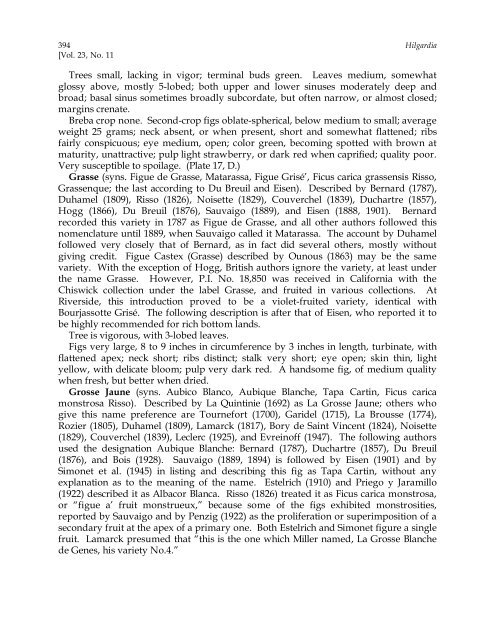Fig Varieties: A Monograph - uri=ucce.ucdavis
Fig Varieties: A Monograph - uri=ucce.ucdavis
Fig Varieties: A Monograph - uri=ucce.ucdavis
You also want an ePaper? Increase the reach of your titles
YUMPU automatically turns print PDFs into web optimized ePapers that Google loves.
394 Hilgardia<br />
[Vol. 23, No. 11<br />
Trees small, lacking in vigor; terminal buds green. Leaves medium, somewhat<br />
glossy above, mostly 5-lobed; both upper and lower sinuses moderately deep and<br />
broad; basal sinus sometimes broadly subcordate, but often narrow, or almost closed;<br />
margins crenate.<br />
Breba crop none. Second-crop figs oblate-spherical, below medium to small; average<br />
weight 25 grams; neck absent, or when present, short and somewhat flattened; ribs<br />
fairly conspicuous; eye medium, open; color green, becoming spotted with brown at<br />
maturity, unattractive; pulp light strawberry, or dark red when caprified; quality poor.<br />
Very susceptible to spoilage. (Plate 17, D.)<br />
Grasse (syns. <strong>Fig</strong>ue de Grasse, Matarassa, <strong>Fig</strong>ue Grisé’, Ficus carica grassensis Risso,<br />
Grassenque; the last according to Du Breuil and Eisen). Described by Bernard (1787),<br />
Duhamel (1809), Risso (1826), Noisette (1829), Couverchel (1839), Duchartre (1857),<br />
Hogg (1866), Du Breuil (1876), Sauvaigo (1889), and Eisen (1888, 1901). Bernard<br />
recorded this variety in 1787 as <strong>Fig</strong>ue de Grasse, and all other authors followed this<br />
nomenclature until 1889, when Sauvaigo called it Matarassa. The account by Duhamel<br />
followed very closely that of Bernard, as in fact did several others, mostly without<br />
giving credit. <strong>Fig</strong>ue Castex (Grasse) described by Ounous (1863) may be the same<br />
variety. With the exception of Hogg, British authors ignore the variety, at least under<br />
the name Grasse. However, P.I. No. 18,850 was received in California with the<br />
Chiswick collection under the label Grasse, and fruited in various collections. At<br />
Riverside, this introduction proved to be a violet-fruited variety, identical with<br />
Bourjassotte Grisé. The following description is after that of Eisen, who reported it to<br />
be highly recommended for rich bottom lands.<br />
Tree is vigorous, with 3-lobed leaves.<br />
<strong>Fig</strong>s very large, 8 to 9 inches in circumference by 3 inches in length, turbinate, with<br />
flattened apex; neck short; ribs distinct; stalk very short; eye open; skin thin, light<br />
yellow, with delicate bloom; pulp very dark red. A handsome fig, of medium quality<br />
when fresh, but better when dried.<br />
Grosse Jaune (syns. Aubico Blanco, Aubique Blanche, Tapa Cartin, Ficus carica<br />
monstrosa Risso). Described by La Quintinie (1692) as La Grosse Jaune; others who<br />
give this name preference are Tournefort (1700), Garidel (1715), La Brousse (1774),<br />
Rozier (1805), Duhamel (1809), Lamarck (1817), Bory de Saint Vincent (1824), Noisette<br />
(1829), Couverchel (1839), Leclerc (1925), and Evreinoff (1947). The following authors<br />
used the designation Aubique Blanche: Bernard (1787), Duchartre (1857), Du Breuil<br />
(1876), and Bois (1928). Sauvaigo (1889, 1894) is followed by Eisen (1901) and by<br />
Simonet et al. (1945) in listing and describing this fig as Tapa Cartin, without any<br />
explanation as to the meaning of the name. Estelrich (1910) and Priego y Jaramillo<br />
(1922) described it as Albacor Blanca. Risso (1826) treated it as Ficus carica monstrosa,<br />
or “figue a’ fruit monstrueux,” because some of the figs exhibited monstrosities,<br />
reported by Sauvaigo and by Penzig (1922) as the proliferation or superimposition of a<br />
secondary fruit at the apex of a primary one. Both Estelrich and Simonet figure a single<br />
fruit. Lamarck presumed that “this is the one which Miller named, La Grosse Blanche<br />
de Genes, his variety No.4.”
















![Fig Trees in North Carolina [Archive] - IDigMyGarden ... - Figs 4 Fun](https://img.yumpu.com/26905320/1/190x245/fig-trees-in-north-carolina-archive-idigmygarden-figs-4-fun.jpg?quality=85)